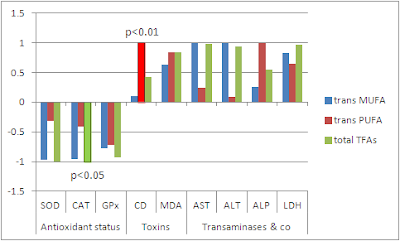 |
| Image 1: The Meet the Fats campaign is part of the stultification... ah I mean educational program of the American Heart Association |
Meanwhile, even mainstream dietitians are beginning to understand that fats, which have been a, if not THE staple energy source in human history are not the bad boys the anti-fat hysteria of the 1980s would make us believe. Even the American Heart Association begins to advocate the use of "healthy fats" as part of a "heart healthy diet" - unfortunately,
the AHA guys still lump Sat (that is the obese guy in the left) Trans (that is the sleazy guy in green) together, although the evidence against poor Sat (who obviously represents all saturated fats) is less conclusive than that against Poly, his money-grubbing sister who would do everything for her sponsors from the corn-industry... well, be that as it may, today's charge is against Trans who is accused of arson, or whole body inflammation, to be precise ;-)
New evidence against Trans is provided by two teams of experts, one from Europe (
Bendson. 2011) and the Middle East (
Dhibi. 2011). In what I personally would consider battery, Nathalie T. Bendson and her colleagues from Denmark and France assigned 52 (formerly ;-) healthy women randomly to receive
either 15.7g partially hydrogenated soybean oil or control oil without any industrially produced trans fatty acids (IP-TFA) on a daily basis. The results were not life-threatening, but certainly not desirable:
After 16 weeks, IP-TFA intake increased baseline-adjusted serum tumor necrosis factor (TNF) by 12% more in the IP-TFA group compared with controls. Plasma soluble TNF receptors 1 and 2 were also increased by IP-TFA.
With TNF-alpha's role in the modulation of endothelial and vascular smooth muscle cell function as well as endothelial cell-blood cell interaction and "the importance of such alterations for
vascular dysfunction, the
initiation and progression of atherosclerosis" (
Kleinbongard. 2010), Bendson et al.'s asssumption that
the IP-TFA-associated increase in cardiovascular risk beyond the adverse effect explained by changes in blood lipids may be partly due to induction of systemic low-grade inflammation
is possibly correct. Nevertheless,
the jury is still out on how bad TNF-alpha actually is, as its role in cardiovascular disease is actually quite ambiguous with the aforementioned low-grade inflammation on the one hand and its ability to protect your heart by ischemic conditioning on the other hand.
 |
| Figure 1: Trans fat content of fresh soy oil, oxidized soy oi and margarine (data based on Dhibi. 2011). |
More comprehensive evidence comes from a rodent study by Dhibi et al. who fed 48 male Wistar rats one out of four experimental diets which were either
high in fat and included 20% fresh soybean oil diet (FSO), 20% oxidized soybean oil diet (OSO) and 20% margarine (MG) or based on the standard chow (control) with a protein/carbohydrate/fat ratio of 17/62/4 for 4 weeks (
Dhibi. 2011). The liver function of the rats, as evidenced by the elevated transaminase levels (ALT, AST) and the increases in alkaline phosphatase (ALP) and lactate dehydrogensase (LDH) in figure 2, took a major beating.
 |
| Figure 2: Relative changes in transaminases (ALT, AST), alkaline phosphatase (ALP) and lactate dehydrogensase (LDH) in rats after 4 weeks on diets containing 20% fresh soybean oil, oxidized soybean oil or margarine (data calculated based on Dhibi. 2011) |
I suppose the sponsors of the
American Heart Association won't like this observation, but it is as plain as the nose in your face that even the "transfat free, heart-healthy polyunsaturated soybean oil" led to statistically significant increases in alkaline phosphatase (ALP) and lactate dehydrogenase (LDH) levels... what, ah... of course that is because the diet was high in fat - how could I forget that 20% fat is still way too much and humans, just like rats should eat a 62% carb 4% fat diet ... I guess that was enough sarcasm for one blogpost, so let's back to the facts, now.
 |
Figure 3: Correlation between fatty acid isomers in the diet and oxidative stress
parameters in rat’s liver and plasma hepato-specific enzymes (data based on Dhibi. 2011). |
The changes in liver function were accompanied by
profound reduction in antioxidant enzyme activity (SOD: superoxide dismutase; GPx: glutathione peroxidase; CAT: catalase) and increased accumulation of conjugated dienes (CD) and malondialdehyde (MDA), the respective correlations of which with the fatty acids isomers (trans fats from mono-unsaturated and poly-unsaturated fatty acids, as well as total transfat content) are plotted in figure 3.
 |
| Image 2: Rat liver histology. |
Due to its scale (only two different transfat profiles, i.e. oxidized soybean oil and margarine)
the study's statistical power is yet so small that we can only make a definite case against the total transfat content for decreases in catalase activity and oxidized polyunsaturated fatty acids for the accumulation of conjugated dienes. With correlations in the the >0.5 and <-0.5 range for many other suspects and crimes, I will yet leave it up to you, the jury, to decide, which members of the transfat family (I suppose the
American Heart Associations Trans character must have a whole bunch of children, then - just like in every honorable mafia family ;-) are to be held responsible for which of these crimes against health, the ultimate result of which you see in the histological changes in the livers of the rats fed with oxidized soy oil (OS) and margarine (MG)... So, members of the Jury, on the Case of Trans Fatty Acid (and his mafia clan) vs. the Suppversity, what you say?




